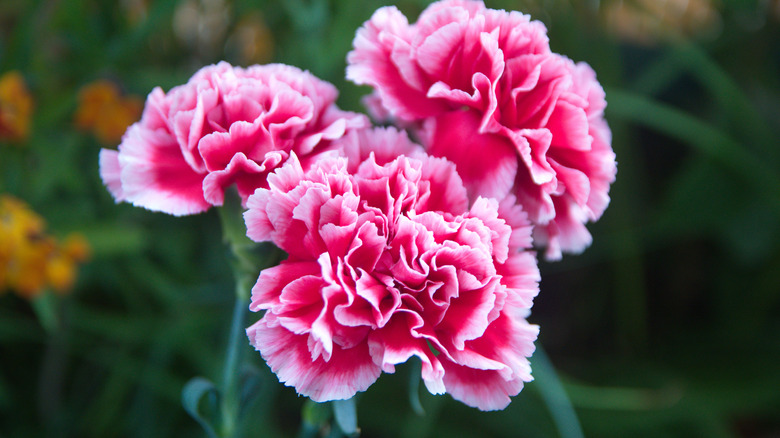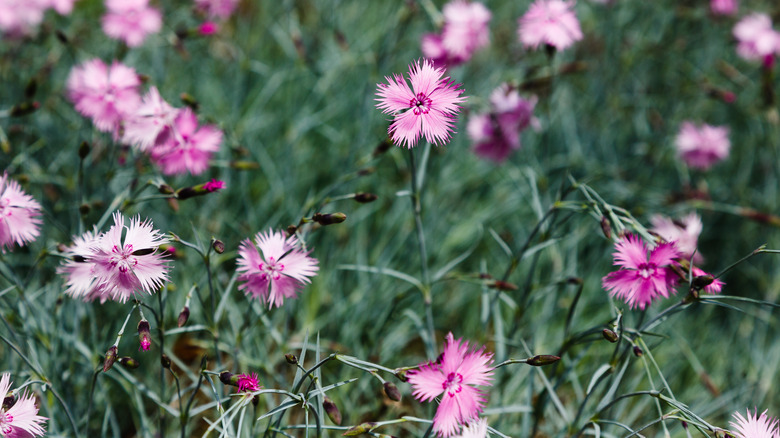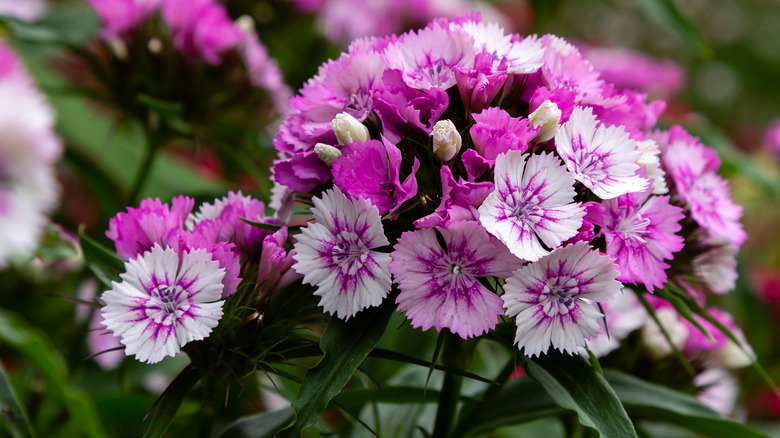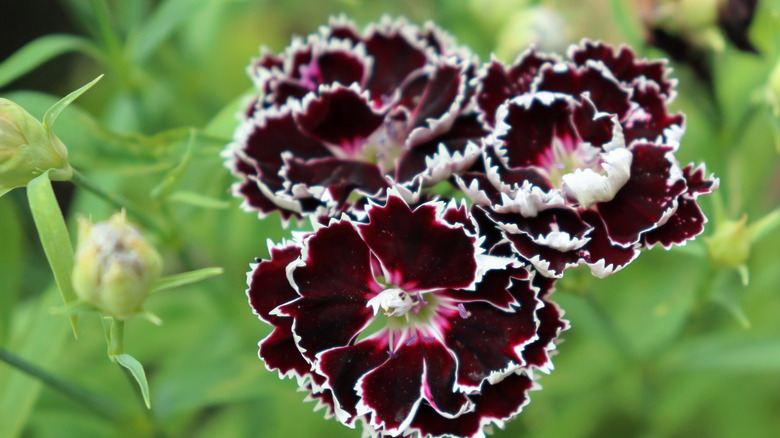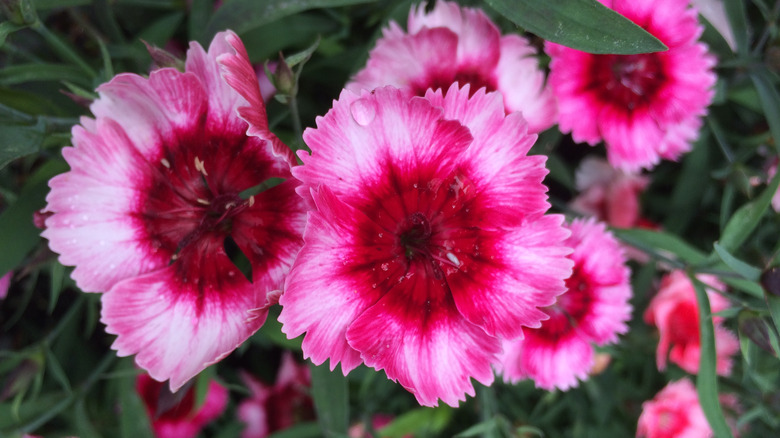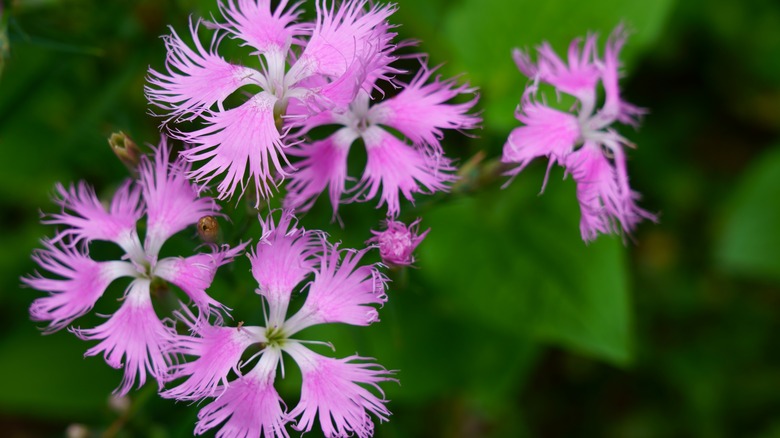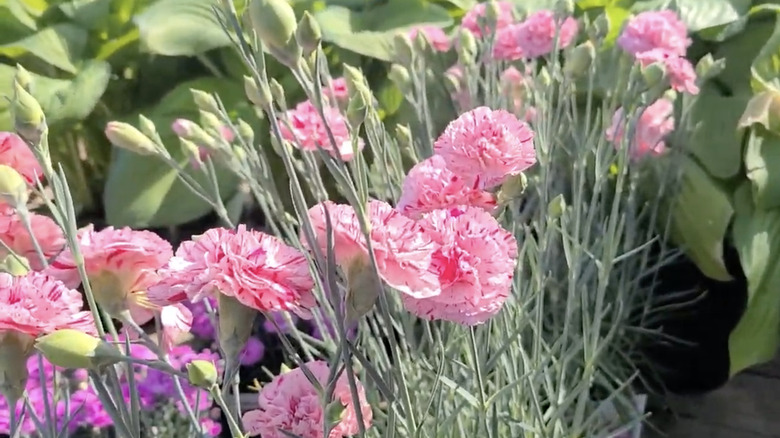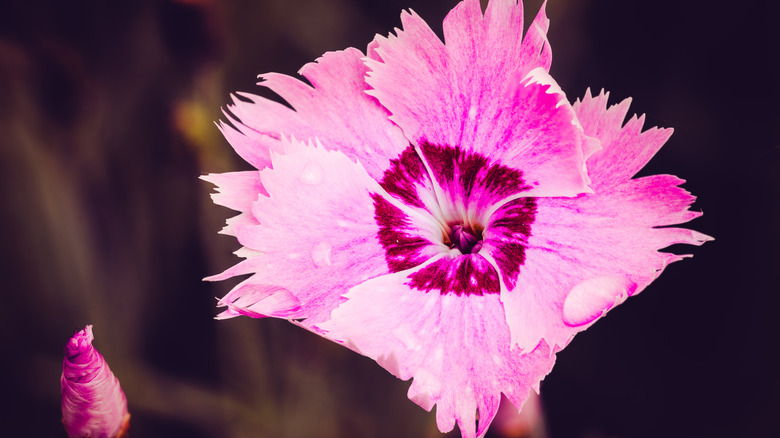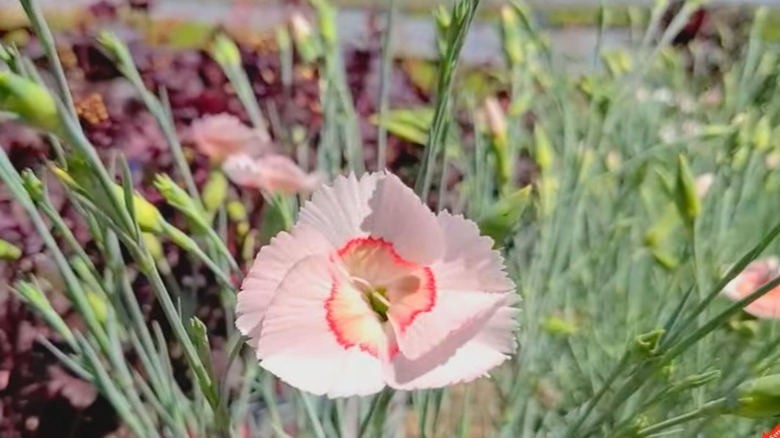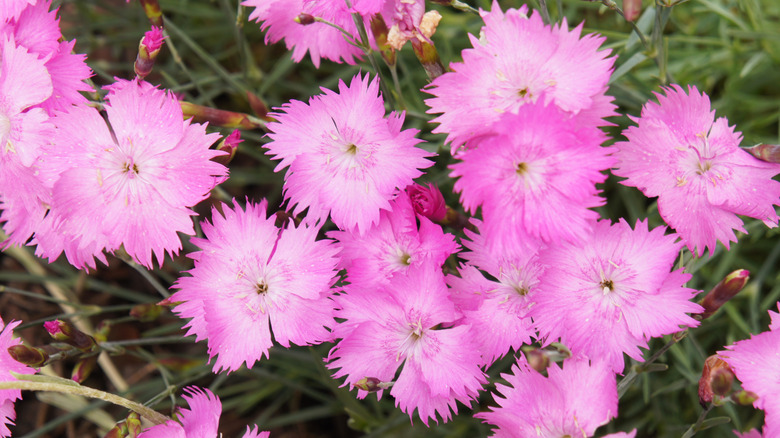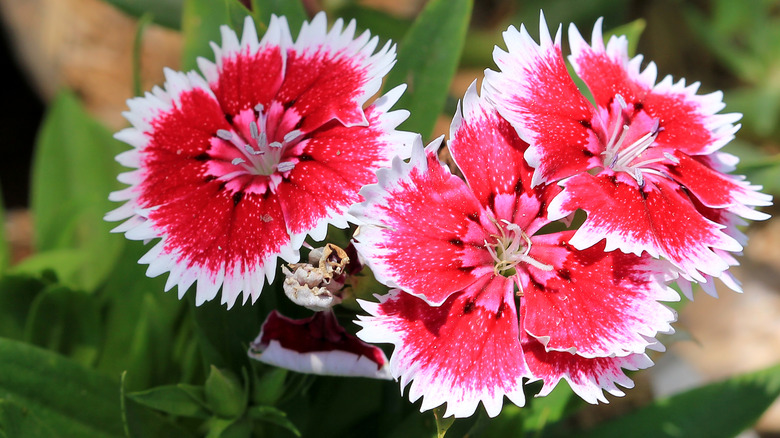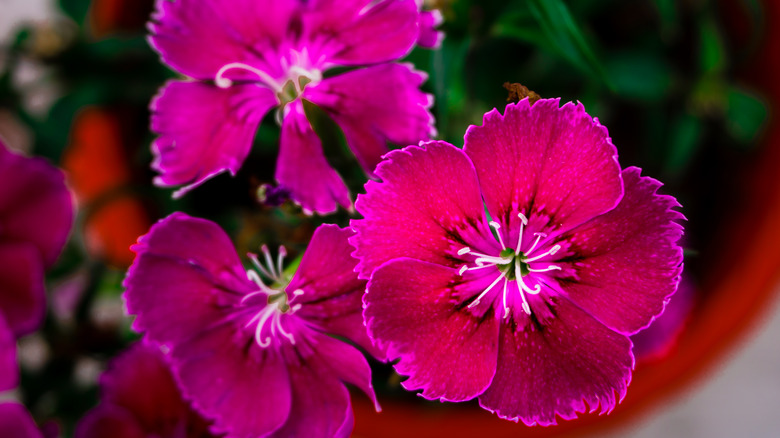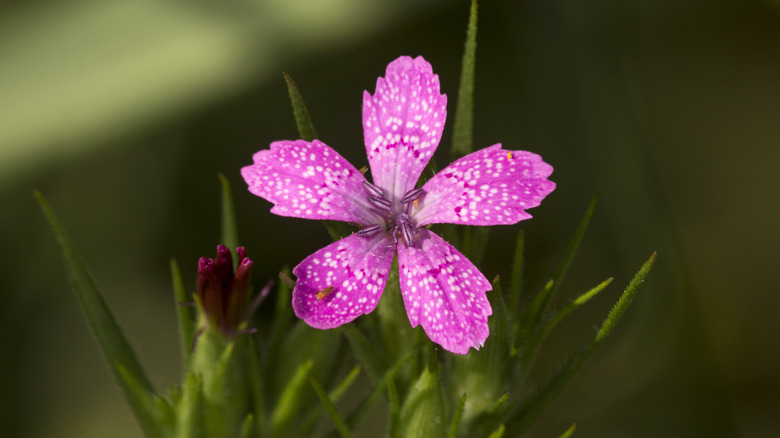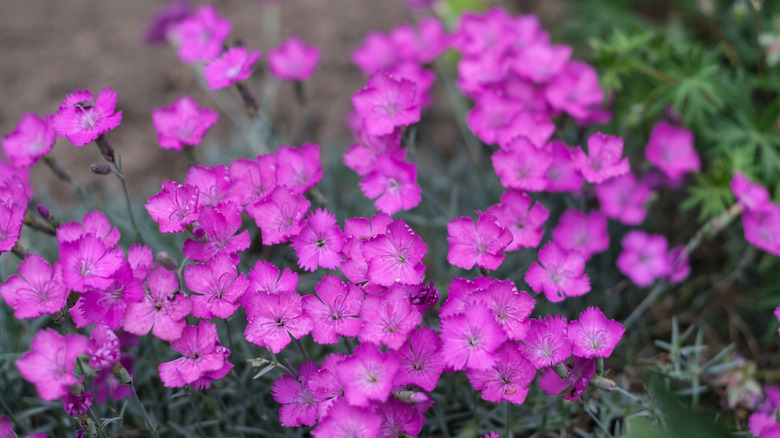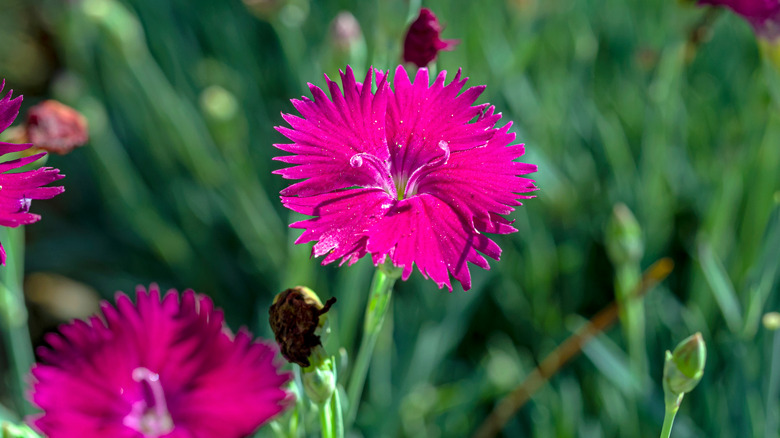15 Stunning Carnations That Will Brighten Your Home
While you've probably seen plenty of cut carnations in vases and bouquets before, did you know they're also a super easy plant to grow in your home? These herbaceous perennials are of hearty stock and come in a variety of colors and shapes, ranging from vibrant reds to deep violets. Carnations are broken up into three major groups, according to Truly – standard or large-flowered, miniature or spray, and mini carnations.
Many folks feel intimidated by the prospect of growing flowers in their home and often opt for succulents and cacti due to their low maintenance and stunning shapes. But having a vibrant pot of flowers on the kitchen counter or in the living room can be an instant mood booster. Carnations are easy to grow and brilliant flowers with as much variety between shapes and sizes as colors. Learn about the wonderfully diverse Dianthus species and get ready to start planting.
1. Clove pink
The quintessential carnation, the clove pink (Dianthus caryophyllus), is what usually comes to mind when folks think of carnations. Thought to have grown natively in the Mediterranean, it's hard to pin down the exact origins, as they are rarely seen in the wild now and are mostly produced through cultivation and engineering, per Nature and Garden. But common does not mean basic — these blooms are festive and eye-catching thanks to their tufted double flower petals and gorgeous color variety. It needs full sun exposure (around 6 hours per day) and well-drained, neutral to alkaline soil.
2. Cottage Pink
One of the most popular blossoms found in many gardens, the cottage pink (Dianthus plumarius) is sort of the model single flower carnation variety. They are also known as Pheasant's Eye Pink, Feathered Pink, and Scotch Pink. They need plenty of circulation, says Jersey Yards, so consider putting them in a rock-laden flower pot for air and drainage. Additionally, they need full sun exposure and well-drained slightly alkaline to neutral soil. The flowers bloom from spring to mid-summer and have a spicy, sweet fragrance.
3. Sweet William
Sweet Williams (Dianthus barbatus) is a lovely flower that goes by many names — Bearded Pink, London Tufts, and Bloomy Down, just to name a few, per Gardenia. Sweet Williams bloom in tight, dense clusters, and the blossoms can be single or double flowers. You can find sweet Williams in a variety of shades, but they are best known for their bi-color blooms that feature light petals and a dark ring or eye. Give them full sun exposure and neutral to alkaline, well-drained soil to keep your sweet William happy.
4. Black Velvet and Lace
Directly related to the Chinese Pink carnation, Black Velvet and Lace (Dianthus chinensis heddewigii) are beloved for their deep red, nearly black petals and delicate white fringe. As a biennial plant, this flower takes two full years to complete its life cycle from seed to flowering but is well worth the wait. Thompson Morgan also notes their tantalizing sweet scent, making this a great indoor plant. It requires full sun exposure and rich, well-drained neutral to alkaline soil.
5. Dianthus 'Superstar'
These stunning blooms are the Dianthus 'Superstar,' and with good reason. The characteristic deep crimson eyes that fade to delicate sakura pink fringed petals are show-stopping beauties, especially against blue-green stems and leaves. Blue Stone Perennials also notes that they have a sweet fragrance, and if you decide to plant your Superstar outside, it is a butterfly magnet, making these an excellent choice for a pollinator-friendly garden. The Dianthus 'Superstar' does best in loose, sandy alkaline soils and full sun exposure.
6. Fringed Pink
The Fringed Pink (Dianthus superbus) is an out-of-this-world-looking carnation, most noted for its feather-like fringed petals. It can be found in much of Northern Europe and parts of Northern Asia, says First Nature, generally blooming in the summer. These are popular for cottage gardens thanks to their hardiness. They thrive in well-drained slightly alkaline soil with full sun exposure. Missouri Botanical Garden recommends frequent clipping of blossoms at the end of their life cycle to prolong the bloom season.
7. Dianthus Pinball Wizard
With a name just as funky as its looks, the Pinball Wizard is a sublime showcase of the carnation. Pale pink double flowers dabbled with hot pink Pollack-like splatters make this unusual blossom a favorite amongst cottage gardeners. According to Gardenia, the Pinball Wizard hybrid is part of Whetman Pinks Devon Cottage Garden PinkSeries. The Pinball Wizard does best in alkaline to neutral, well-drained soils and with full sun exposure. Add this zany flower to your home for an instant mood booster.
8. Sequier's Pink
Blossoming in summer and early fall, the Sequier's pink (Dianthus seguieri), or Ragged pink, is a feathery carnation that grows natively in southern Europe and in high-altitude meadows, says iNaturalist, meaning it can likely do well in dry-arid climates. Seguieri is a name chosen to honor the 18th-century French botanist Jean-François Séguier. Opt for well-draining potting soil and keep your Sequier's pink in full sunlight to help this rosy dianthus thrive indoors.
9. Dianthus Georgia Peach Pie
Another part of the Whetman Pinks carnations, the Georgia Peach Pie is part of the American Pie series that have been specially engineered for their sumptuous scents and long blooming season, says Gardenia. The pale peachy center and crimson border easily call to mind a fresh, ripened stone fruit, all set against the soft pale blush pink double flower, making for an irresistible combination. Plant your Georgia Peach Pie carnation in neutral to alkaline, well-drained soil with full sun exposure for best results.
10. Northern Pink
While the northern pink, or boreal carnation (Dianthus repens), may look nearly identical to the Sequier's pink (Dianthus seguieri), the two actually grow natively in completely different climates. As its common name indicates, the northern pink grows in some of the coldest northernmost places, like Alaska and the Yukon, as well as Inner Mongolia and Siberia, as per iNaturalist. That's just how hardy this breed is. To keep boreal carnations in your home, make sure they are exposed to full sun and planted in slightly acidic sandy or clay loam.
11. Rainbow Pink
Rainbow pink, or China pink (Dianthus chinensis), is a stunning carnation found in China, Korea, Mongolia, and Russia. Its petals range from pure white to salmony pink and ruby red, and often present with bi or even tricolor patterns, complete with a white lacy fringe. Beyond its stunning beauty, it's also been used in Chinese medicine for over 2,000 years, according to Natural Medicinal Herbs. This exotic blossom blooms in early spring through late summer. Give them full sun exposure and dry to lightly moistened, well-draining alkaline soil.
12. Maiden Pink
The Maiden Pink carnation (Dianthus deltoides) is a resilient, low-maintenance flower that is highly drought-resistant, requiring very little water, says Nature and Garden. Deltoides comes from the Greek symbol for Delta and was given to the Maiden Pink for its tapered petals. Good drainage is essential to keeping this plant happy. Additionally, it should be planted in a pot with neutral to alkaline soil and with full sun exposure. Otherwise, the plant becomes susceptible to rot and disease, so be careful not to over-water.
13. Deptford Pink
This speckled beauty is known as the Deptford pink (Dianthus armeria). Its common name was given due to the prevalence of this carnation species in Deptford, England, says the Native Plant Trust, but this dianthus is found natively throughout continental Europe. Brought to American gardens, this plant is now semi-naturalized in North America. It's beloved for its deeply-hued pink-purple petals and signature white freckles. The Deptford pink requires alkaline, well-drained, fertile soil and at least six hours of sunlight per day.
14. Peacock-eye Pink
Commonly called the Peacock-eye Pink (Dianthus pavonius), this slender growing single-flower carnation grows from evergreen, lush grass-like stems, according to iNaturalist. Thanks to the evergreen stems, like many carnation varieties, you won't have to trim these down in the fall or winter. The petals come in many shades of pink, from pale blush to fiery fuchsia, and have serrated edges. Grow these in normal-to-acidic or sandy soil and give them full sun exposure to keep the blossoms happy.
15. Dianthus Neon Star
The Neon Star spray carnation is an impressive variety of dianthus, thanks to its many flowers and vibrant pink shades. While the flowers may look delicate, this carnation variety is actually extremely hardy and able to tolerate heat and humidity much better than other carnations, says Plant Addicts. Additionally, they can thrive in acidic, neutral, or alkaline soils, making these a great perennial flower even for inexperienced gardeners. They are also a tidy flower, so you can plant them as filler flowers or on their own.

